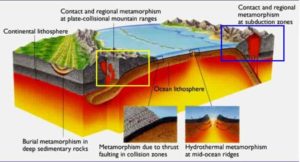
Contact Metamorphism Vs. Regional Metamorphism
Metamorphism is the solid change in minerals and textures in a pre-existing rock (country rock) due to changing pressure / temperature conditions. Fluids like H2O also have a very important role to play.
Regional metamorphism occurs as a result of convergent tectonic activity and is usually characterised by low temperature and high pressure conditions. Thus this type of metamorphism is often associated with orogenic events and over a large area causes metamorphism. Under regional metamorphic conditions, Barrovian zone sequences and structures such as folds are formed.
Conversely, contact metamorphism usually occurs under higher temperature conditions associated with ignorant intrusions on a smaller scale. The high temperatures ‘ bake’ the surrounding country rock as the magma intrudes into the country rock and a metamorphic aureole is formed. The formed rocks are usually called hornfels.
The three types of metamorphism
Contact Metamorphism
Contact Metamorphism occurs when magma comes into contact with an existing rock body. When this happens, the temperature of the existing rocks rises and is also infiltrated with the magma fluid. The area affected by magma contact is usually small, ranging from 1 km to 10 km. Contact metamorphism produces rocks like marble, quartzite, and horns that are non-foliated(rocks without any cleavage).
Regional Metamorphism
Regional metamorphism takes place over a much wider area. This metamorphism creates rocks like gneiss and schist. Large geological processes such as mountain-building cause regional metamorphism. When exposed to the surface, these rocks show the incredible pressure that causes the mountain building process to bend and break the rocks. Regional metamorphism usually produces gneiss and schist-like foliated rocks.
Dynamic Metamorphism
There is also dynamic metamorphism due to mountain building. These enormous heat and pressure forces bend, fold, crush, flatten, and shear the rocks.










